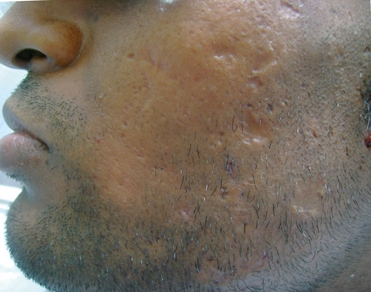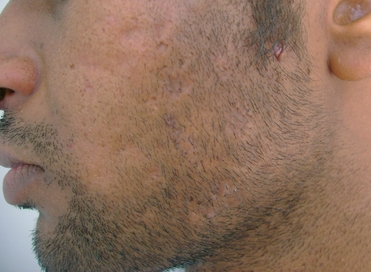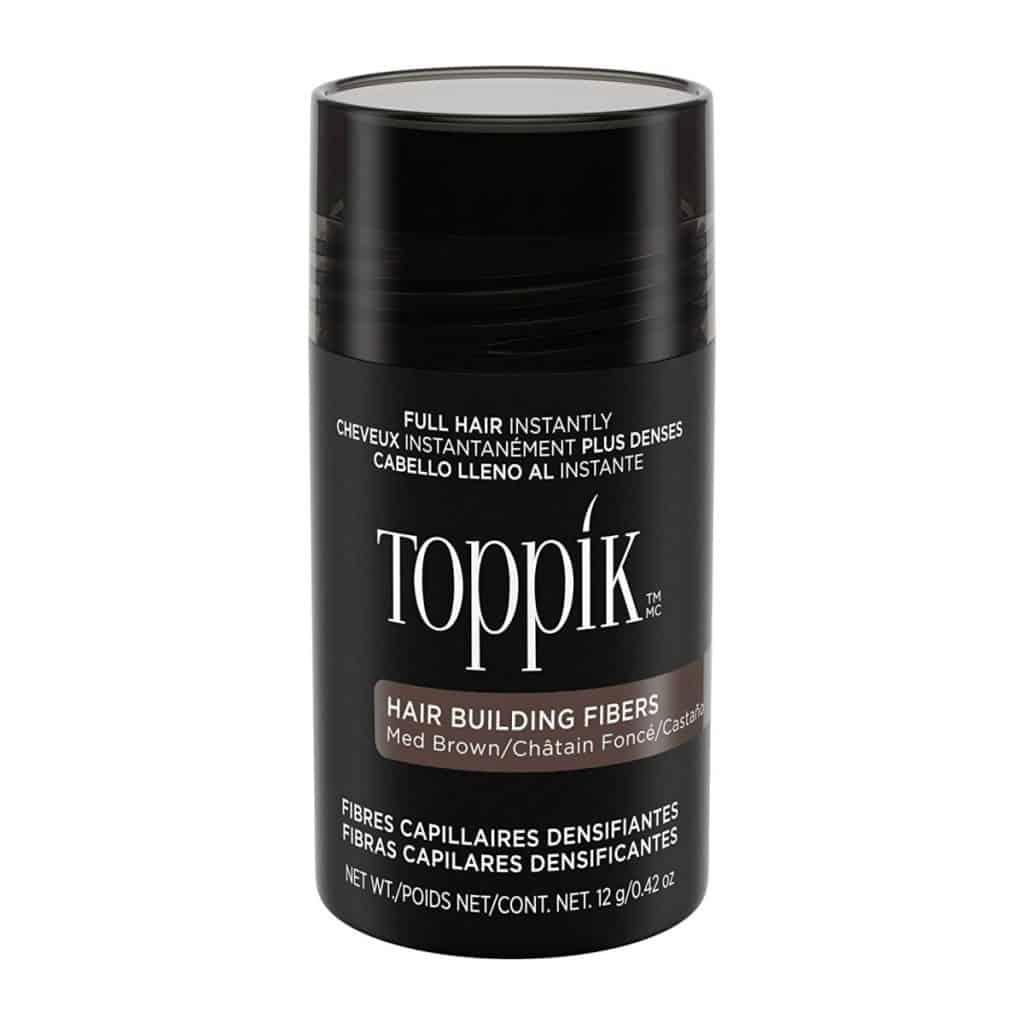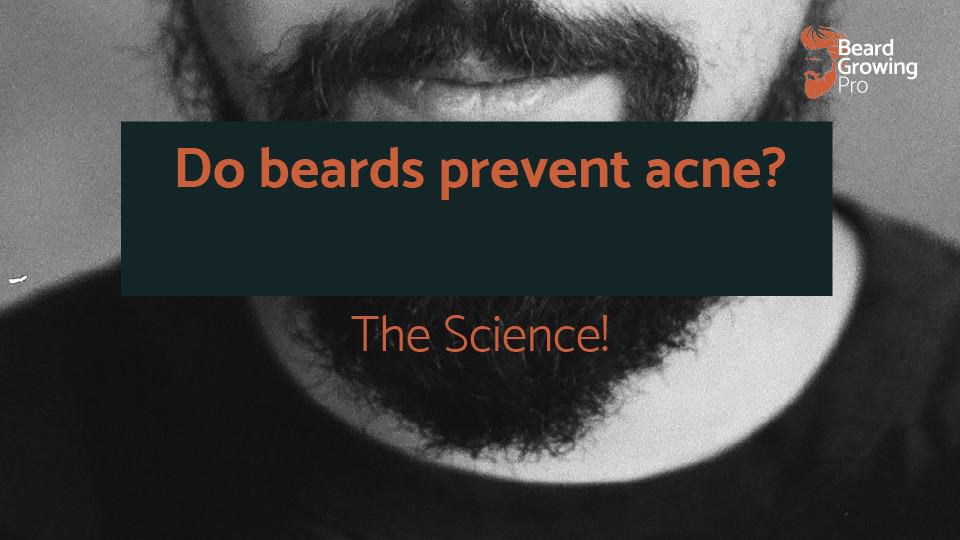Acne is a long-term skin condition that rears its ugly head when dead skin cells and oil from the skin get stuck in the hair follicle or pore. Many people wonder if beards cause acne or if beards help prevent acne. The scarring that occurs after the onset of acne can be a cause of concern if you want to grow a beard.
Severe acne scarring can prevent hair follicles from producing beard hair. If the scar tissue directly impacts the hair follicle, no more hair will grow on that site. However, some people can grow a full beard after severe acne as the skin can recover without impacting the follicles.
Acne is a common skin disorder in teenagers, affecting 95–100% of 16–17-year-old boys and 83–85% of 16–17-year-old girls and persisting in roughly 12–14 % of cases throughout adulthood.
Acne affected 633 million people in 2015 and is most common in adolescence due to the wild fluctuation in hormones during puberty. It commonly results in these symptoms:
- Whiteheads (closed plugged pores)
- Blackheads (open plugged pores)
- Small red, tender bumps (papules)
- Pimples (pustules), which are papules with pus at their tips
- Large, solid, painful lumps beneath the surface of the skin (nodules)
- Painful, pus-filled lumps beneath the surface of the skin (cystic lesions)
The results can mean that there is a lot of anxiety and reduced self-esteem from the person afflicted.
Article Contents
What is acne scarring?
Acne scarring results from a deep trauma to the skin caused by acne. During an acne outbreak, external factors such as picking can cause deeper trauma and result in permanent scarring.
Acne scars are either pitted or raised skin and can occur anywhere on the face or body.
Acne scars are formed when collagen is not produced in enough volume while the wound is healing.
There are three different types of scarring:
- Boxcar scars look like wide U-shaped scars that can be shallow or deep.
- Ice pick scars are typically narrow, and the shape goes deep into the skin. They can extend very deep into the skin’s surface and are hard to treat.
- Rolling scars have rounded edges and are irregular in appearance. They are particularly wide but not deep.
The imperfect healing process caused when acne forms on the face can be graded according to several different scales, including lesion counting; subjective self-assessment; Acne Scar Rating Scale (ASRS); evaluator-based qualitative and quantitative scarring grading systems; Echelle d’Evaluation Clinique des Cicatrices d’acne (ECCA); Global Scale for Acne Scar Severity (SCAR-S); and imaging.
Does scarring affect beard growth?
Depending on the severity of the acne scarring, it can affect hair growth and the formation of the beard.
A severe case of acne scarring
In a study reported in 2012, a 24-year-old male presented with complaints of post-acne scarring on his face. He, unfortunately, suffered from severe acne throughout his life and had no active acne by the age of 24.
There were multiple large superficial boxcar scars on his cheeks, and it resulted in complete hair loss inside the scars, which made them much more visible when compared to the surrounding beard hair and skin.

The patient underwent follicular unit grafting that used a selection of hairs from his chin for transplantation into the scar area. The patient was reevaluated after three months, and they found an almost 80% uptake of the grafts, which were transplanted from the chin to the scarred areas.
This is what his skin looked like after the procedure:

You can see that the scarring is much less obvious when it has been transplanted with donor’s hairs, and the grafting easily hides the scars.
Mild forms of acne scarring
In less acute acne scarring, the damage to the skin may not go deep enough to affect beard hair growth.
The effect of acne scarring on beard hair will vary from person to person and depends on the positioning of the acne scarring and how much of the face it covers.
Does acne slow facial hair growth?
Acne does not slow down facial hair growth. The beard hair will regularly grow once the hair follicle is healthy enough to grow hair.
This rate is different for each person, but, on average, the growth rate for human hair is about 1.25 centimetres or 0.5 inches per month, or about 15 centimetres or 6 inches per year. The rate is about 0.35 millimetres daily – think of it like this, and you probably won’t get annoyed!
As long as the hair follicle can produce beard hair and remain healthy, it can grow. The presence of acne around the hair growth site does not impede the rate of facial hair growth.
How to avoid acne scarring
Some people are more likely to see acne scars once that acne clears and is typically related to how the person has treated the acne and genetic risk factors.
The risk of acne scarring increases when:
- the acne includes cysts that penetrate deep into the skin
- the patient picks and distresses the acne during the healing process
- The person delays treatment. If the patient has inflammatory acne, scarring is greater if no treatment is sought.
- A relative has acne scarring – genes play a large role in determining whether or not someone will develop acne scarring.
Depending on the severity of the acne, it may take up to 3 to 6 months for the marks to disappear completely. However, the deeper the trauma to the skin, the more likely the damage will be permanent.
The less trauma you put your skin through, the better your chances of being able to grow a beard after acne has subsided.
To avoid acne scarring, you should pay particular attention to the following to minimise the chance of developing acne scars.
Treat acne as soon as it develops,
It will help if you treat acne as soon as it develops. It is much easier to control acne in the earlier stage of the condition. Quick treatments help keep the breakout to a minimum and prevent acne from developing more severe problems.
Reduce inflammation and seek treatment
should you notice large inflamed blemishes, you should try to calm your skin by using products suitable for sensitive skin and avoiding harsh skincare products and excessive scrubbing or rubbing.
Do not pick pimples
picking at your acne is very tempting. I touch my face a lot during the day and will subconsciously pick at blemishes.
Picking at your face can quickly deepen the scar and spread the infection to other areas of your face.
Popping pimples is very tempting as they are satisfying to pop, and it feels productive in minimising the number of whiteheads on your face. However, popping pimples can easily extend the healing time and increase the chance of leaving a permanent scar.
Leave your acne to heal on its own.
Do not pick while healing
While your acne is healing, do not be tempted to pick away the scabs that form during the healing process.
Scabs are an important part of your body’s natural healing process.
Picking at them can increase the likelihood of infection and deepen the trauma to your skin, which can easily damage beard hair follicles and limit your hair growth on that site.
If you are worried that you cannot grow a beard because of acne scarring, you should check out the options below for increasing your beard growing potential.
Options for acne beards
There are three major options for growing a beard despite acne scarring. The first is to grow your beard longer to cover up the areas of weaker growth caused by acne scarring. Secondly, you can opt for a beard transplant which is a proven way to increase the density of a beard. And, finally, you can use hair fibres to thicken up your beard to cover up any problem areas.
Grow your beard longer
Firstly, you can grow a longer beard to cover up acne scarring.
This approach is particularly successful if your acne scarring is superficial and sparse.
Growing the beard hair around the scarring can quickly cover any low-density areas. I recommend growing the beard hair for approximately three months to see if waiting and growing out your beard can help improve the problem areas caused by your acne scarring.
If your acne scarring is particularly bad, you can opt for a surgical approach called follicular unit grafting.
Follicular unit grafting
Surgery can seem like a particularly extreme intervention for growing a beard—the increased risk of infection and the chance of rejection of the grafted hair follicle.
A study from 2013 shows that facial hair can be transplanted using a procedure called follicular unit grafting and by using the smallest recipient sites possible to insert the grafts.
The study looked at eyebrows, goatees, moustache, and beard transplants. The key points from the study are:
- angulation is a critical point to achieving aesthetic results – the surgeon has to make sure that the recipient sites are as set a shallow angle as possible to the face to create the best results.
- There is a certain danger zone in the beard where pumps can occasionally form. It is located in the vertical central column extended from the lower lip to the chin. Bumps can occasionally form from hairs transplanted in this area.
Hair transplants can last a lifetime and can be very successful when performed by a clinic.
Patients commonly choose follicular unit extraction and grafting because the hair can be cut short and can still be shaved in some cases. For a successful transplant, the donor site must be chosen based on hairs similar in texture and colour to the normal beard hairs.
Hair fibres
If you are struggling to grow a long enough beard and surgery seems a bit too extreme, you can consider applying hair fibres to the hairs that already exist on your face.
Hair building fibres can be applied by shaking the hairs over the beard’s surface or using a spray applicator attachment.

Shaking the hair building fibres covers a large area but if you want a more precise application then go with the applicator attachment. This simply provides a puff of air to deliver the hair fibres.
Use this beard darkening product as follows:
- dry and style your hair as usual – hair fibres used static to stick to the hair so having as dry a hair as possible will work better.
- Apply the hair fibres using the applicator or shake over the area where you want darker results.
- Some products come with a hairline optimiser that can be inserted to the edges of the beard to achieve a more natural line.
- Gently pat the hair to disperse the hair fibres and stop any clumps that have formed from staying.
- Consider using a fibre hold spray which is specially formulated to increase the bond between the hair building fibres and your hair. This will mean that it lasts for as long as possible.
These will last until you wash your beard hair in the shower. But it should be easy to apply the next time that you want your beard to appear darker.
Summary
This article has gone over everything you need to know about whether or not beards grow on acne and the interventions you can use to boost your beard hair density and cover up any deep acne scarring.
Depending on the severity of your acne scarring, you may or may not be able to grow beard hair. If the acne scarring penetrates deeply into the skin, it is much less likely that you will grow a beard as it will damage the beard hair.
Using surgical interventions such as follicular unit grafting and applying hair fibres may be the best option for fixing and hiding the issue of gaps in your beard caused by acne scarring.
Prevention is much better than cure, and looking after your skin properly during an acne outbreak will ensure that your beard can grow thick and strong in the future. Luckily, surgical approaches can help grow a beard should the scarring kill the hair follicle.
If you want to know more about beards and acne, check out my other article where I go through everything you need to know about whether or not beards prevent acne – I look at the science and share all of the important aspects with you.


![Do beards grow on acne scars? [The science you need to know]](https://beardgrowingpro.com/wp-content/uploads/2022/01/Do-beards-grow-on-acne-scars.jpg)

